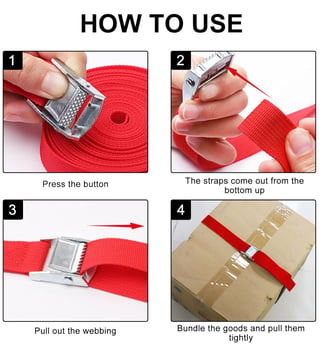How ratchet mechanism Work: A Comprehensive Guide for Secure Cargo Control
"Discover how ratchet mechanism work in heavy-duty cargo securing. Learn key components, technical specs, and industry applications for logistics & freight control. Boost safety & efficiency with TRUCKBROTOOLS' expert insights. Shop now!"
TIE DOWN
How Ratchet Tie-Down Mechanisms Work: A Comprehensive Guide for Secure Cargo Control
When it comes to securing heavy loads during transportation, ratchet tie-down straps are indispensable. Their unique ratchet mechanism ensures cargo stays firmly in place, even under harsh conditions. But how exactly does this mechanism work? In this blog post, we’ll break down the engineering behind ratchet tie-downs, their key components, and why they’re a game-changer for truckers, logistics managers, and DIY enthusiasts.
------
What Is a Ratchet Tie-Down?
A ratchet tie-down combines a flat webbing strap with a ratchet mechanism and metal fittings to create a secure, adjustable cargo-binding system. Unlike elastic bungee cords, ratchet straps don’t stretch, making them ideal for heavy-duty applications like securing machinery, vehicles, or construction materials .
------
Key Components of a Ratchet Tie-Down
Before diving into the mechanics, let’s identify the core parts:
1. Flat Webbing Strap
◦ Made from high-strength polyester or nylon, the strap resists abrasion and UV exposure.
◦ Widths range from 25mm to 100mm, with breaking strengths up to 10 tons .
2. Ratchet Mechanism
◦ The heart of the system, featuring interlocking ratchet teeth and a pawl (a metal catch).
◦ Available in manual (hand-cranked) or automatic (spring-loaded) versions.
3. Metal End Fittings
◦ Includes hooks, snaps, or D-rings for attaching to anchor points.
◦ Often coated with rubber or plastic to prevent paint damage .
------
How the Ratchet Mechanism Works
Let’s dissect the step-by-step process of tightening and releasing a ratchet tie-down:
Step 1: Tensioning the Strap
• Manual Ratchet: Pull the free end of the strap through the ratchet lever. Crank the handle clockwise to wind the strap tightly around the load.
• Automatic Ratchet: Pull the strap to engage the spring-loaded pawl, which automatically locks the teeth in place as tension increases .
Step 2: Locking the Load
• The ratchet teeth and pawl create a one-way locking system. Once tensioned, the mechanism prevents the strap from loosening, even if the load shifts during transit.
Step 3: Releasing the Strap
• Lift the ratchet lever to disengage the pawl. Pull the strap’s free end to unwind it. For automatic models, a release button or lever is used .
------
Why Ratchet Tie-Downs Outperform Alternatives
1. Precision Control
◦ Adjust tension incrementally for a snug, secure fit. No guesswork like with elastic cords.
2. Durability
◦ Stainless steel ratchets and heat-treated fittings resist rust and wear, even in extreme temperatures (-40°C to 120°C) .
3. Safety
◦ Eliminates the risk of overstretching or snapping, common with bungee cords.
4. Versatility
◦ Compatible with trucks, trailers, boats, and even DIY projects like securing furniture .
------
Common Applications
• Freight Transport: Secure pallets, machinery, and auto parts.
• Construction: Stabilize heavy equipment on flatbed trucks.
• Marine Use: Tie down boats on trailers or docks.
• Camping: Fasten tents, tarps, or kayaks to rooftops .
------
Maintenance Tips for Longevity
• Inspect Regularly: Check for frayed straps or bent ratchet teeth.
• Lubricate: Apply silicone spray to moving parts to prevent jamming.
• Avoid Overloading: Exceeding the rated capacity (e.g., 5,000 lbs) weakens the mechanism.
------
Choosing the Right Ratchet Tie-Down
Consider these factors:
• Load Capacity: Match the strap’s working load limit (WLL) to your cargo.
• Strap Width: Wider straps distribute force evenly, reducing breakage risk.
• End Fittings: Snap hooks are user-friendly; D-rings suit heavy-duty needs.
------
The Science Behind the Ratchet
The ratchet mechanism operates on simple physics:
1. Friction and Locking: The pawl catches between ratchet teeth, creating friction to hold tension.
2. Torque Resistance: As you crank the handle, torque builds up until the load reaches maximum tension.
This design ensures static friction keeps the load secure, while dynamic friction allows smooth tightening .
------
Real-World Example: Securing a Motorcycle
1. Attach one end of the ratchet strap to the trailer’s anchor point.
2. Loop the strap around the motorcycle’s frame and attach the other end.
3. Crank the ratchet until the motorcycle is immobilized.
4. Double-check tension before driving.
------
FAQ: Ratchet Tie-Downs
Q: Can I reuse a ratchet strap after a single use?
A: Yes! High-quality straps are reusable, but inspect for damage after each use.
Q: How do I prevent slippage?
A: Use straps with non-slip coatings or add rubber sleeves to the ratchet.
Q: Are automatic ratchets better than manual ones?
A: Automatics are faster for routine tasks, while manuals offer finer tension control.
------
Conclusion
The ratchet tie-down mechanism is a brilliant fusion of simplicity and engineering excellence. By understanding how it works, you can maximize cargo safety, reduce accidents, and save time. Whether you’re hauling freight across the country or securing a boat for a weekend trip, investing in a reliable ratchet tie-down is a smart choice.
------
Optimize Your Cargo Security Today
Ready to upgrade your securing system? Explore our range of ratchet tie-downs designed for heavy-duty applications. Shop now and experience the difference precision engineering makes!





